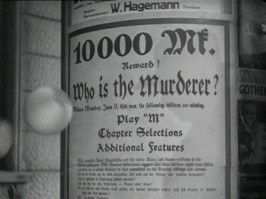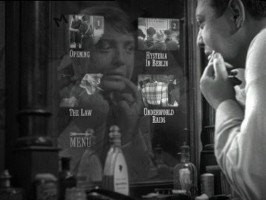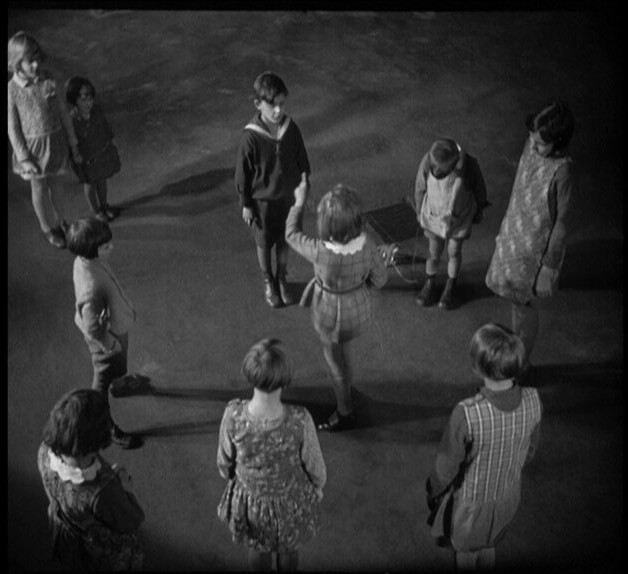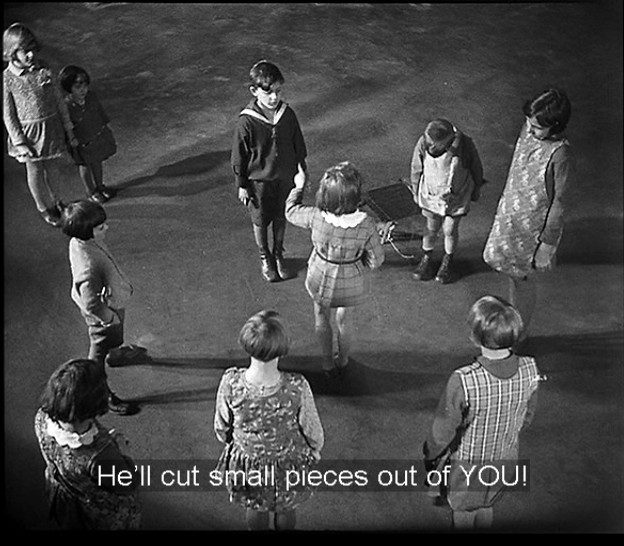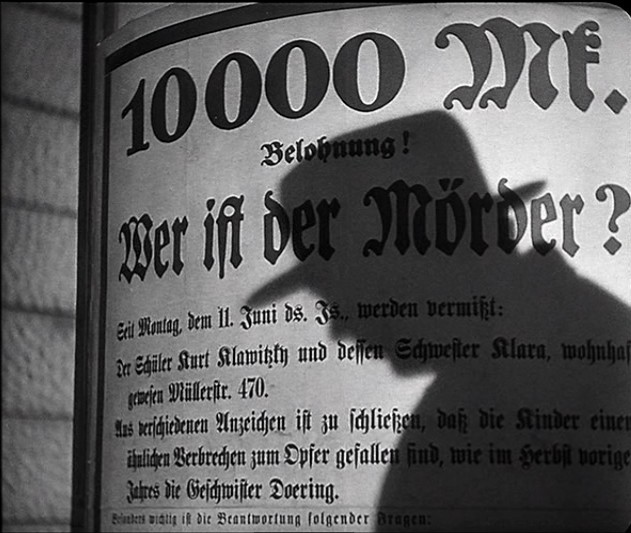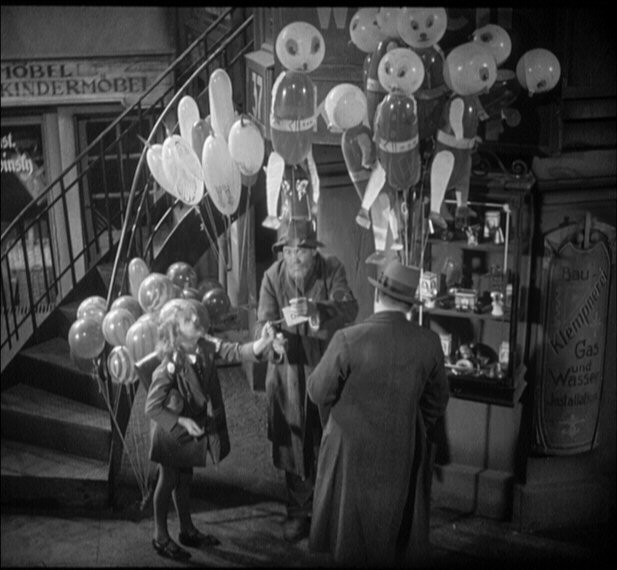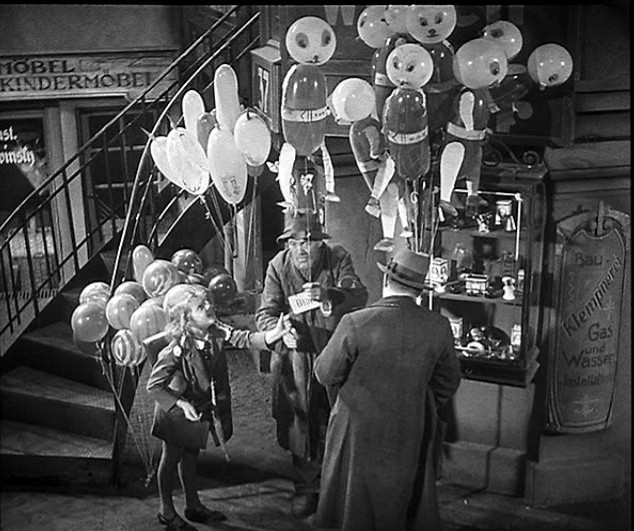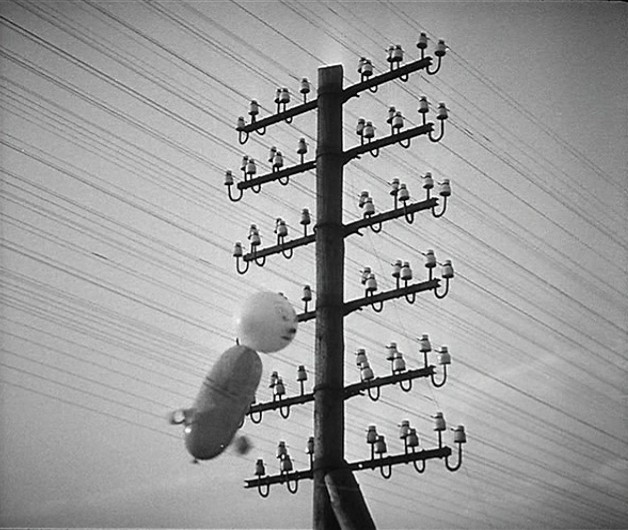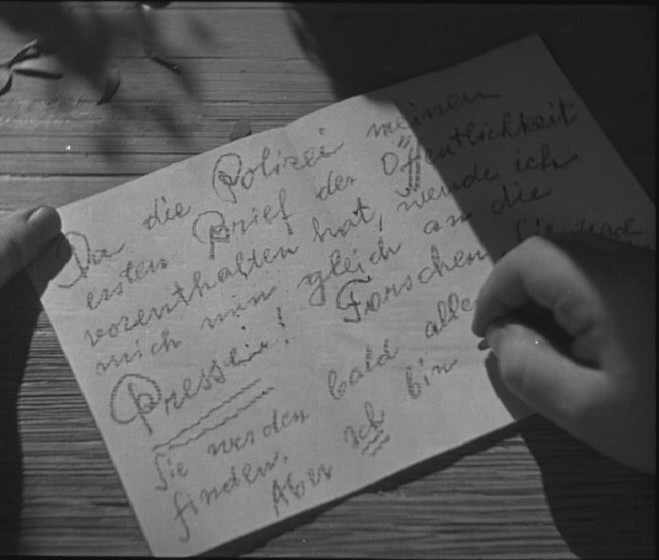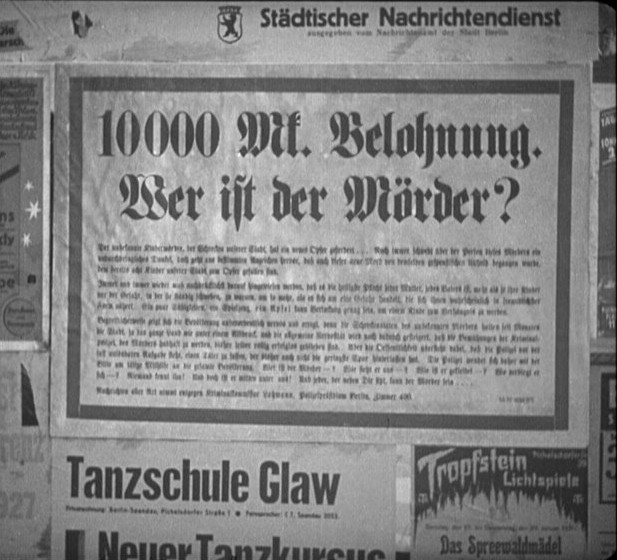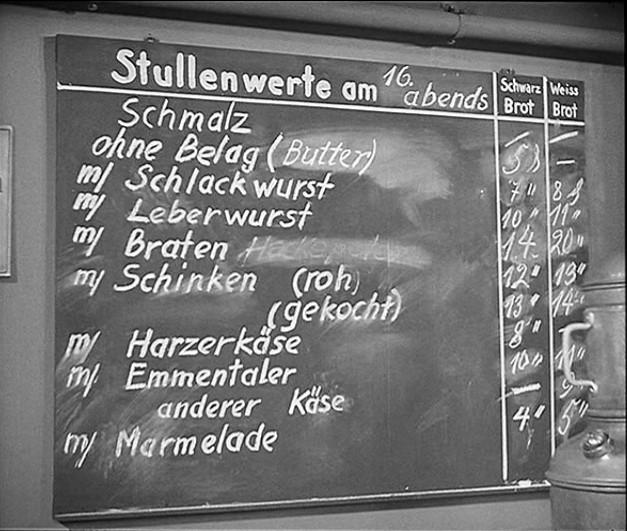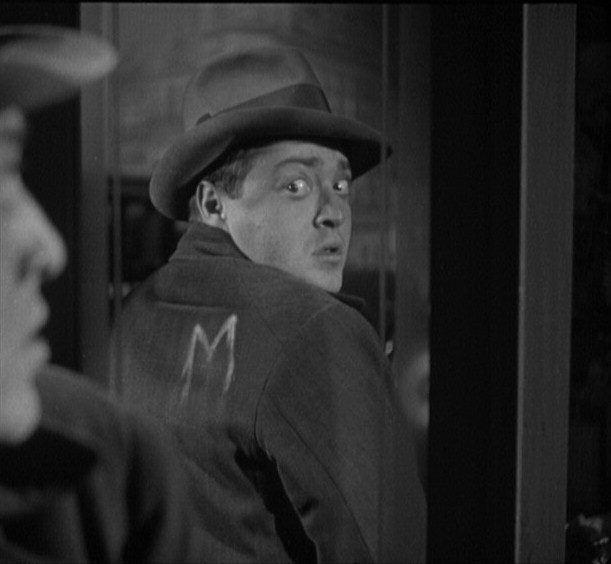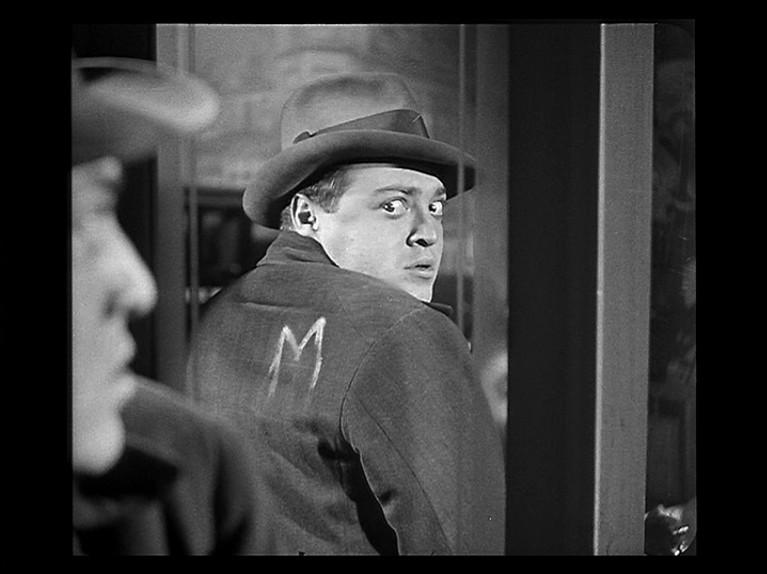![]()

![]()

(aka "M - Eine Stadt sucht einen Mörder" or "M. - Mörder unter uns" or "The Murderers Are Among Us" or "M - Your Murderer Looks At You))
directed
by Fritz Lang
Germany 1931
A simple, haunting phrase whistled off-screen tells us that a young girl will be killed. “Who is the murderer?” pleads a nearby placard as serial killer Hans Beckert (Peter Lorre) closes in on little Elsie Beckmann… In his harrowing masterwork, Fritz Lang merges trenchant social commentary with chilling suspense, creating a panorama of private madness and public hysteria that to this day remains the blueprint for the psychological thriller. The Criterion Collection is proud to present a new restoration of this landmark film.
******
Austrian-born Fritz Lang made M in Germany where it premiered in May 1931 before being banned by the Nazis three years later. In 1940, parts of the film were appropriated by the Nazis in their propaganda film Der Ewige Jude (The Eternal Jew) contorting Peter Lorre's soulbaring performance for anti-Semitic ends. In retrospect, many believe M hastened Lang's departure from Germany in 1934. The Nazis were offended by the film's original title,
Murderers Among Us, assuming it was about them and Lang had difficulty getting permission to make the film at the studios where it was eventually made in its entirety.
Except from Nick Wrigley's detailed DVD review found HERE at Masters of Cinema
Posters
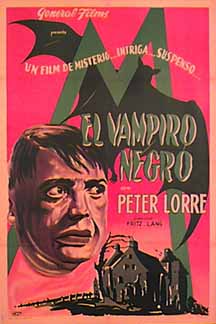 |
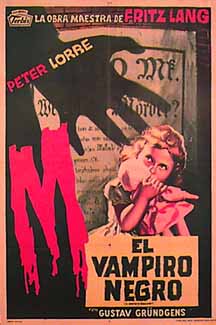
|
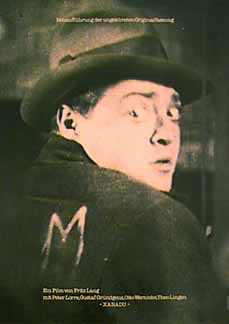
|
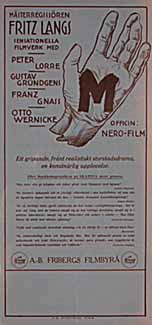 |
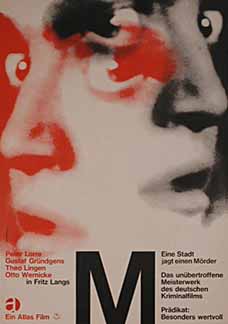
|
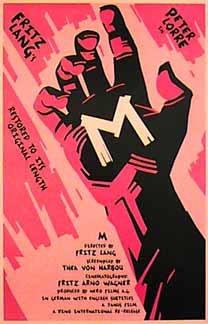 |
Theatrical Release: May 11th, 1931 Germany
Reviews More Reviews DVD Reviews
DVD Comparison:
BMG Video - Region 2- PAL vs. Criterion - Region 0 - NTSC vs. Criterion (2 -disc re-issue)- Region 0 - NTSC vs. Eureka Video (2 disc) - Region 2 - PAL
Big thanks to Nick Wrigley of Masters of Cinema for the Eureka Screen Captures! and Bram Blijleven for the BMG caps.
(BMG Video (Germany) Region 2- PAL - LEFT vs. Criterion - Region 0 - NTSC - 2nd vs. Criterion (2 disc e-issue) - Region 0 - NTSC 3rd vs. Eureka - Region 2 - PAL - RIGHT)
| DVD Box Covers |

|
|
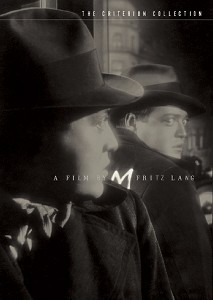 |
|
|
NOTE: Purchases through DVDBeaver's links to Amazon help keep us afloat and advertisement free! |
||||
| Distribution |
BMG Video
Region 2 - PAL |
Criterion Collection - Spine #30 Region 0 - NTSC |
Criterion Collection - Spine #30 (re-issue) Region 0 - NTSC |
Eureka
Video
Region 2 - PAL |
| Runtime | 1:45:28 (4% PAL speedup) | 1:50:32 | 1:50:48 | 1:45:00 (4% PAL speedup) |
| Video |
1:10:1 Aspect Ratio Average Bitrate: 8.45 PAL 720x576 25.00 f/s |
1.27:1 Aspect Ratio |
1.17:1 Aspect Ratio Average Bitrate: 8.41 mb/s NTSC 704x480 29.97 f/s |
1:1.19
Original Aspect Ratio |
| Audio | German (Dolby Digital 2.0) - restored | German (Dolby Digital 1.0) | German (Dolby Digital 1.0) |
German (Dolby Digital 1.0) |
| Subtitles | None | English, and none | English, and none | English, and none |
| Features |
Release Information: Studio: BMG Video Aspect Ratio:
• The Blue Angel trailer • Portrait of Fritz Lang • Text Cards • Photos
DVD
Release Date: October 28th, 2002 Chapters 18
|
Release Information: Studio: Criterion / Home Vision Entertainment Aspect Ratio: Discographic Information:
Chapters
18
|
Release Information: Studio: Criterion / Home Vision Entertainment Aspect Ratio: Discographic Information:
Chapters 16 |
Release Information: Studio: Eureka Video Aspect Ratio:
Disc One
• M - German Audio, optional English subs
• Full length audio commentary by Martin Koerber with excerpts from
"Bogdanovich interviewing Lang in the 60s"
• Documentary - The Restoration Of M, Peter Campbell.
Disc Two
• Audio Interview - Peter Bogdanovich with Fritz Lang
• Documentary - "For Example: Fritz Lang" (German, 1960s)
• Visual Essay - "Lending Order to Terror" by R. Dixon
Smith
• Film Restoration and Comparison - Martin Koerber
• Photo Gallery and animated slideshow
• Set designs and final screen comparisons
• Animated biographies and historical backgrounds
DVD
Release Date: October 6th, 2003 Chapters 25 |
ADDITION - Criterion - re-issue (Dec 2004) - These captures were done a long time ago before we perfected the 'first frame' system so I can't 100% vouch for their exactness in regards to matching. They are pretty close though.
In my opinion the Criterion is the best image in regards to sharpness and contrast, but it loses some appeal as it is cropped slightly on both edges. The subtitles are superior in appearance to its nearest rival - the Eureka DVD.
The Eureka image has always looked 'thin' to me and we have had a few complaints about it not playing on certain DVD players. I believe the problem dealt with interlacing. I suspect it of having some contrast boosting, but I can find no 'zooming in' proof. It does look digitally manipulated at times. I don't recommend an upgrade from the Eureka unless you want some the Criterion's amazing extra features. Both disc are marvelous and those with Criterion's older release are strongly recommends to 'double dip'. It is worth it.
*******************
At DVDBeaver, we are big fans of Criterion. We think they are hands down the best DVD production company in the world. So when Criterion gets beat out, its news... and in this case they have never been outdone so decisively. In comparison to the October 6th, 2003 Eureka Region 2 disc release, the Criterion shows a much poorer image quality, cropping, darker and substantial damage marks, scratches and lines. I think the Criterion may be zoomed in at times as the cropping is not consistent in many images. Both have the original mono sound. The 2 disc Eureka is full of Extras. Criterion has none. Recent quote:
M (1931, Lang) "We do hope to revisit M sometime in the future, but nothing is definite at this time." - Jon Mulvaney, Aug 2003
BIG thanks to Nick Wrigley of Masters of Cinema for giving us this breakdown of the treatment of the film.
************
1931 - 'M' (length 117 minutes) is registered at the Berlin censors office in April. Premiered on May 11th at 111 minutes.
1934 - 'M' banned by Nazis not to be released again for 26 years.
1960 (March) - 'M' re-released, re-edited by a third party with added sounds, dialogue, and generally regarded to be a huge botch up. Shown at 99 minutes.
1995 - restored, but this was a faulty restoration. It was framed incorrectly at 1.33:1 didn't use the best source material and actually included segments from, generally regarded as, an undesirable rehash of Lang's original film. (This is the version Criterion used).
2002 - Martin Koerber definitive restoration (Eureka version). Does not contain any "bits" from the 1960 re-release, and is the most faithful representation of what we know the 1931 release.
************
So, as we see , we are almost looking at two different films. It is hard to fault Criterion, as their single layered DVD did come out 5 years before the Eureka. At the time I remember remarking to a friend how wonderful we thought the transfer was.
The Eureka disc is very sharp but it is not perfect. Its sharpness and brightness are
quite unusual for a film over 70 years old and if we look closely...
it does have some
contrast boosting and the "edge-enhancement halos" are evident (Check
the grab of the large blackboard - the title "Stullenwerte"). With its
flaws I would still recommend it. This
is another example for North American film fans to obtain a Region-free player.
NOTE BMG ADDITION:
The BMG release has
restored and bumped sound (to 2.0), but still looks inferior to me to
the Eureka release. I suspect it was from the same transfer though, with
Eureka doing a better job of digital cleanup. It should be noted the BMG
release has no subtitles.
When you insert the BMG DVD it starts playing a trailer of Der Blaue Engel, also a BMG release. For extra's there are text cards and photo's and a short clip of a German tv show about Fritz Lang (Portrait of Fritz Lang from Kino).
ADDITION (Quote from Torsten Kaiser - Supervisor of the Production and Digital cleanup of the Eureka DVD )
The 2003 finalized
restoration transfer for the Eureka issue are NOT the same ( as the BMG
- UFA ) - and your screenshots tell you as much, too.
As I already mentioned in the audio commentary in some scenes - we did a
complete new transfer on a High Definition Spirit Datacine, and
corrected all the flaws that the 2002 transfer (which UFA and Arte made
their masters from) had, mainly lack of detail, accuracy in sharpness
and grey scale and even significant flaws in the digital clean-up. The
image now appears exactly as it does on the 35mm restoration archival
protection master print.
With reference to the issue of "haloes" and "contrast boost" - the
former is a flaw not of the transfer or the compression as much as it is
one of our PAL (and also NTSC) confines. At 625 line resolution maximum
for PAL with only 576 reserved even for 16x9 PAL resolution issues,
Standard Definition creates a huge problem when it comes to detail. The
halo issue is one of them. These do not exist on 35mm or on High
Definition tape. But SD can only handle substantially less in resolution
and has to "compress" the lines. If one bit of information is picked up
by two lines, you have a nasty flickering effect as the frequencies
overlap. The overwhelming majority of major classic releases on DVD are
transferred both wetgate and with the aid of the automatic process of
Digital Video Noise Reduction, and the image is further "cleaned" by
slightly blurring the information in the picture frame. This allows the
companies to save money on the clean-up (as wetgate fills many scratches
and makes them "disappear", the same with DVNR which reduces the number
of small debris and dirt) and the blur can get rid of moire patterns and
crosstalk that result in the flickering - but it also dramatically
reduces the resolution and detail of the entire picture frame and robs
it of all its texture.
This is not as it should be. Instead, we did not utilize any of the
mentioned processes, making the transfer from the best film element
possible without any automatic tools. No blur, either. Now, we could
have made a flickering here or there (in scenes wherever it occurs)
disappear as well - but what about the rest of the frame, where all the
detail is perfectly preserved ? Should it be sacrificed ? Should Peter
Lorre look soft and out of focus because a very tiny frequency flutter
is in the background ? What about clothing, set design, sign posts ?
It all would have looked dull. That is why I took the consious decision
to keep all possible detail intact - why I went for maximum in texture
rather than an overall "undisturbed image", the mistake that was done in
2002 - which merely would have been a result of additional technological
"fakery" anyway, and would have little to do with what's on the 35mm
element. We corrected this in 2003.
Finally, with regard to the "contrast boost" - this is no flaw. This is
the actual image from the 35mm element as the scene was lit brighter
that the other two transfers falsely indicate. The lighting on the set
was bright and gave the chalk on the board a very bright shimmer, and
with the limitations of Standard Defintion the appearance is as it comes
across. But there is NO blooming. We checked it several times with
reduced contrast levels on the element itself - they did still contain
texture. And tested on a 120 inch screen here at THE LASER EXAMINER the
finished DVD looks very good, as does the interview with Fritz Lang (FOR
EXAMPLE, FRITZ LANG) on Disc 2, that I also transferred at the same
facility.
DVD Menus
(BMG Video
(Germany) Region2- PAL - LEFT vs. Criterion
- Region 0 - NTSC - RIGHT)
NOTE: On Eureka Menu - The menus are wonderfully animated, with almost CGI like graphics. The ball bounces against the left side of the poster and has nothing to do with selecting things on the menu. Lorre's shadow moves in from the right and says "Wie heist du?" (what's your name?") --- a menu option is selected by a red "M" cursor (not on the screengrab).
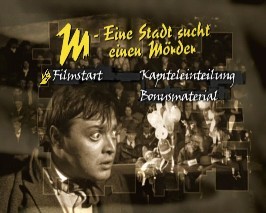 |
|
 |
|
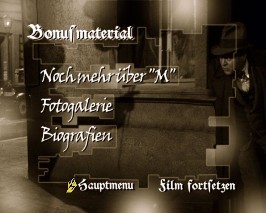 |
|
(Criterion (2 disc e-issue) - Region 0 - NTSC (Disc 1) LEFT vs. Criterion (2 disc e-issue) - Region 0 - NTSC (Disc 2) MIDDLE vs. Eureka - Region 2 - PAL - RIGHT)
|
|
|
|
|
|
|
|
|
|
|
|
|
|
|
|
NOTE: Because of the manner in which these films are shown, neither edition images have had size manipulation. You are seeing them both in their native resolution. Because of the differences of PAL and NTSC, which usual result in a significant difference in comparable resolutions, this is the first time that this is happening on DVDBeaver.
Subtitle Samples
(BMG Video (Germany) Region2- PAL - TOP vs. Criterion - Region 0 - NTSC - 2nd vs. Criterion (2 disc re-issue) - Region 0 - NTSC 3rd vs. Eureka - Region 2 - PAL - BOTTOM)
|
|
|
|
|
|
|
|
Screen Captures
(BMG Video (Germany) Region2- PAL - TOP vs. Criterion - Region 0 - NTSC - 2nd vs. Criterion (2 disc re-issue) - Region 0 - NTSC 3rd vs. Eureka - Region 2 - PAL - BOTTOM)
|
|
|
|
|
|
|
|
(BMG Video (Germany) Region2- PAL - TOP vs. Criterion - Region 0 - NTSC - 2nd vs. Criterion (2 disc re-issue) - Region 0 - NTSC 3rd vs. Eureka - Region 2 - PAL - BOTTOM)
|
|
|
|
|
|
|
|
(BMG Video (Germany) Region2- PAL - TOP vs. Criterion - Region 0 - NTSC - 2nd vs. Criterion (2 disc re-issue) - Region 0 - NTSC 3rd vs. Eureka - Region 2 - PAL - BOTTOM)
|
|
|
|
|
|
|
|
(BMG Video (Germany) Region2- PAL - TOP vs. Criterion - Region 0 - NTSC - 2nd vs. Criterion (2 disc re-issue) - Region 0 - NTSC 3rd vs. Eureka - Region 2 - PAL - BOTTOM)
|
|
|
|
|
|
|
|
(BMG Video (Germany) Region2- PAL - TOP vs. Criterion - Region 0 - NTSC - 2nd vs. Criterion (2 disc re-issue) - Region 0 - NTSC 3rd vs. Eureka - Region 2 - PAL - BOTTOM)
|
|
|
|
|
|
|
|
(BMG Video (Germany) Region2- PAL - TOP vs. Criterion - Region 0 - NTSC - 2nd vs. Criterion (2 disc re-issue) - Region 0 - NTSC 3rd vs. Eureka - Region 2 - PAL - BOTTOM)
|
|
|
|
|
|
|
|
(BMG Video (Germany) Region2- PAL - TOP vs. Criterion - Region 0 - NTSC - 2nd vs. Criterion (2 disc re-issue) - Region 0 - NTSC 3rd vs. Eureka - Region 2 - PAL - BOTTOM)
This capture shows the Pillar-boxing without any cropping.
|
|
|
|
|
|
|
|
Report Card:
|
Image: |
Criterion (re-issue) |
|
Sound: |
- |
| Extras: | Criterion (re-issue) / Eureka tie |
| Menu: | Eureka |
![]()

![]()
DONATIONS Keep DVDBeaver alive:
Mail cheques, money orders, cash to: or CLICK PayPal logo to donate!
|
Gary Tooze
|
|
Thanks...


